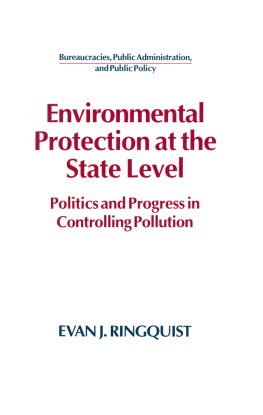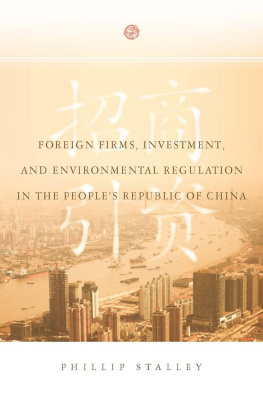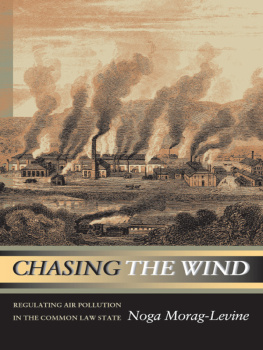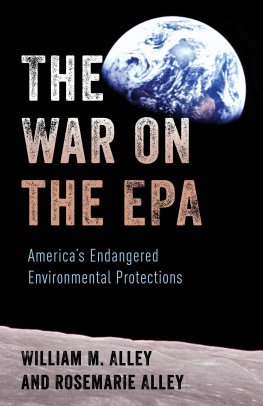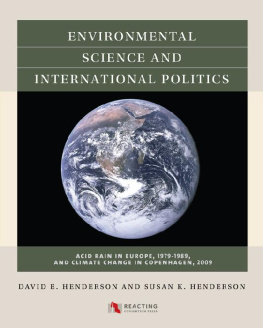Environmental Protection at the State Level
Bureaucracies, Public Administration, and Public Policy
Kenneth J. Meier
Series Editor
THE STATE OF PUBLIC BUREAUCRACY
Larry B. Hill, Editor
THE POLITICS OF DISSATISFACTION
Citizens, Services, and Urban Institutions
W. E. Lyons, David Lowery, and Ruth Hoogland DeHoog
THE DYNAMICS OF CONFLICT BETWEEN BUREAUCRATS AND LEGISLATORS
Cathy Marie Johnson
THE POLITICS OF TELECOMMUNICATIONS REGULATION
The States and the Divestiture of AT&T
Jeffrey E. Cohen
WOMEN AND MEN OF THE STATES
Public Administrators at the State Level
Mary E. Guy, Editor
ETHICS AND PUBLIC ADMINISTRATION
H. George Frederickson, Editor
ENVIRONMENTAL PROTECTION AT THE STATE LEVEL
Politics and Progress in Controlling Pollution
Evan J. Ringquist
THE POLITICS OF SIN
Drugs, Alcohol, and Public Policy
Kenneth J. Meier
Bureaucracies, Public Administration, and Public Policy
Environmental Protection at the State Level
Politics and Progress in Controlling Pollution
Evan J. Ringquist
First published 1993 by M.E. Sharpe
Published 2015 by Routledge
2 Park Square, Milton Park, Abingdon, Oxon OX14 4RN
711 Third Avenue, New York, NY 10017, USA
Routledge is an imprint of the Taylor & Francis Group, an informa business
Copyright 1993 Taylor & Francis. All rights reserved.
No part of this book may be reprinted or reproduced or utilised in any form or by any electronic, mechanical, or other means, now known or hereafter invented, including photocopying and recording, or in any information storage or retrieval system, without permission in writing from the publishers.
Notices
No responsibility is assumed by the publisher for any injury and/or damage to persons or property as a matter of products liability, negligence or otherwise, or from any use of operation of any methods, products, instructions or ideas contained in the material herein.
Practitioners and researchers must always rely on their own experience and knowledge in evaluating and using any information, methods, compounds, or experiments described herein. In using such information or methods they should be mindful of their own safety and the safety of others, including parties for whom they have a professional responsibility.
Product or corporate names may be trademarks or registered trademarks, and are used only for identification and explanation without intent to infringe.
Library of Congress Cataloging-in-Publication Data
Ringquist, Evan J. 1962
Environmental protection at the state level: politics and progress in controlling pollution / Evan J. Ringquist.
p. cm. (Bureaucracies, public administration, and public policy)
Includes bibliographical references and index.
ISBN 1-56324-203-6.ISBN 1-56324-204-4 (pbk.)
1. PollutionGovernment policyUnited StatesStates.
2. Environmental policyUnited StatesStates.
3. Environmental protectionUnited StatesStates.
4. BureaucracyUnited StatesStates.
I. Title.
II. Series.
HC110.P55R56 1993
363.7'056'0973dc20
93-12298
CIP
ISBN 13: 9781563242045 (pbk)
ISBN 13: 9781563242038 (hbk)
To Lois, Eric, Erling, and Laurie, without them, none of what I have accomplished would have been possible.
Contents
| by Kenneth J. Meier |
| Chapter |
The M.E. Sharpe series "Bureaucracies, Public Administration, and Public Policy" is designed as a forum for the best work on bureaucracy and its role in public policy and governance. Although the series is open with regard to approach, methods, and perspectives, especially sought are three types of research. First, the series hopes to attract theoretically informed, empirical studies of bureaucracy. Public administration has long been viewed as a theoretical and methodological backwater of political science. This view persists despite a recent accumulation of first-rate research. The series seeks to place public administration at the forefront of empirical analysis within political science. Second, the series is interested in conceptual work that attempts to clarify theoretical issues, set an agenda for research, or provide a focus for professional debates. Third, the series seeks manuscripts that challenge the conventional wisdom about how bureaucracies influence public policy or the role of public administration in governance.
Environmental Protection at the State Level: Politics and Progress in Controlling Pollution falls into the first category. It is a first-rate study of bureaucracy and environmental policy and can serve as a blueprint for how studies of public policy should be designed. Professor Ringquist provides a comprehensive view of the environmental policy process, covering adoption, implementation, and an assessment of the impact of current policies. Too many studies of public policy examine only a portion of the policy process. The current study demonstrates what should be the cutting edge of public policy analysis. It links the politics of adoption to implementation decisions and both of these to the quality of the nation's environment. The study illustrates that the public administration side of public policy (implementation) is crucial to understanding environmental policy in the United States. It also illustrates how the politics of policy adoption shapes and guides public administration.
Environmental Protection at the State Level also contributes to the wave of new studies that reestablish state governments and state politics as central concerns in political science. Environmental policy is only one of many policies that simply would not exist were it not for the active and aggressive role of state agencies. State governments have redefined federalism in the past twenty years. In many policy areas they are the coequal of the federal government; in environmental policy states are the source of much leadership and innovation.
All students of public policy face an inherent dilemma: do I want to contribute to the theoretical literature of political science or do I want to make a contribution to the substantive policy area? Professor Ringquist demonstrates that a scholar can do both. The enforcement of environmental regulations and their impact on the quality of our air and water are key substantive issues in environmental policy. The author addresses them using the theories and methods of a political scientist. As a result Environmental Protection at the State Level: Politics and Progress in Controlling Pollution says something important to both students of environmental policy and political scientists. Professor Ringquist has not resolved in this book all the tensions between substantive public policy and political science. No single book can. But he has provided a solid foundation for the effort.
Kenneth J. Meier
University of Wisconsin-Milwaukee
Why State Environmental Policy?
Many people who pick up this book are likely to hold one of three popular misconceptions concerning environmental regulation. The first misconception is that we fully understand the causes and consequences of environmental policy. Environmental protection has been a hot research topic on and off for over twenty years; what more could possibly be learned? The answer is that while we know a great deal about environmental politics at the federal level, we really know very little about the politics behind state environmental policy. We know even less about the consequences that environmental regulations have had for environmental quality (i.e., the extent to which these efforts have succeeded in protecting the environment). This book begins to fill these gaps in knowledge by analyzing state air and water quality regulations.

